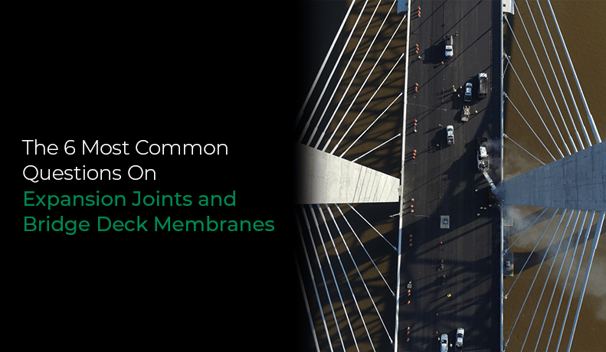Installing Waterproof Sheet Membranes Waterproofing sheet membranes are specified and installed on...
The 6 Most Common Questions On Expansion Joints and Bridge Deck Membranes

We know our industry is a tricky one. There are seemingly limitless requirements and considerations to make for every job, especially with regard to bridge decks. We know firsthand how much of a headache it can be to get the job done right. So we want to clear up some of the most common questions we get asked about expansion joint and membrane installations.
Frequently Asked Questions on Expansion Joints
The Chase Corporation has one type of expansion joint for purchase. We offer a closed-cell foam expansion joint. We work closely with our customers to find the best solution for every job. These are the questions that often come up during those conversations:
1) How Much Do Expansion Joints Cost?
The expansion joint price is determined by the width and depth of the actual expansion joint. In addition, the service environment will dictate the type of closed-cell foam material that would be the best fit for purpose and use. For example, bridge deck expansion joints exposed to sunlight require ultraviolet stabilizers so the expansion joint material does not degrade. For interior exposures, in a warehouse, a less expensive closed-cell foam expansion joint can be used.
You can contact us for a quote by pressing the button below, we will work within your project specifications to get you an accurate number.
2) What’s the Lead Time on Delivery?
For the most part, 5-10 business days. For a more detailed answer, we need to address a few factors.
Our industry has busy periods. For most of the year, you can expect a lead time of 5-10 working days. The end of the year, November for instance, will see a spike in orders as most projects are in their final stages before the cold sets in. The high volume of orders during this period may affect delivery.
There are sectors that experience less fluctuation. Indoor architecture is less susceptible to weather conditions. The same is true for warm states, like Arizona, as their projects have less calendar-induced overlap as their season is year-round.
We should also recognize that order size plays a part too. Large orders may take more time to fulfill.
Related Articles: How to Measure Expansion Joints
3) Do You Provide Onsite Training?
While we cannot guarantee onsite training will be available for every job, we do have resources to assist in installation. We can offer virtual training if needed, demonstrating the installation process, complete with bonder and the real installation steps. We also get requests to demonstrate heat-welding. This demonstration can last an hour.
For more immediate assistance, we have a comprehensive video series outlining the steps required for proper installation. Visit our YouTube channel to get help today.
Frequently Asked Questions on Bridge Deck Membranes
Many of the questions asked about expansion joints come up in our conversations about membranes. Let’s look at a few of those now.
Related Article: 5 Common Mistakes (And 8 Best Practices) For Bridge Deck Membranes
4) How Much Do Membranes Cost?
We do not sell out membranes directly. For pricing, we recommend speaking to one of our distributors. To find out the name of a distributor in your region, contact us with an inquiry; we will direct you to the best source.
Related Article: An Intro to Membrane Surface Preparation for Bridge Decks
5) How Big are Membranes?
Our membranes are 4 ft wide and 50 ft long. However, depending on the size of the bridge deck, we have the capacity to manufacture rolls of the membrane as long as 200 feet.
6) What’s the Coldest Temperature for Membrane Installation?
The project specification will call out the project temperature parameters. However, Chase Corporation manufactures a low-temperature primer- adhesive that can be applied down to 25 degrees Fahrenheit. The product is Roybond 740. The waterproofing sheet membranes are not temperature sensitive and can be installed at any temperature. The primary concern, when temperatures drop below 35 degrees Fahrenheit, is the potential formation of microscopic ice crystals in the concrete bridge deck.
Bridge deck membranes play a crucial role in protecting the structural integrity of bridges and supporting a long service life. They serve as a waterproofing barrier that protects against moisture from damaging the structure. There are many factors to consider while installing this membrane, and these questions only begin to scratch the surface of this conversation.
If you have more questions that are not answered here, reach out! Leave us a comment on this post or talk with us directly. You can get in touch with us today, and our experts will do all they can to help support your operation.








